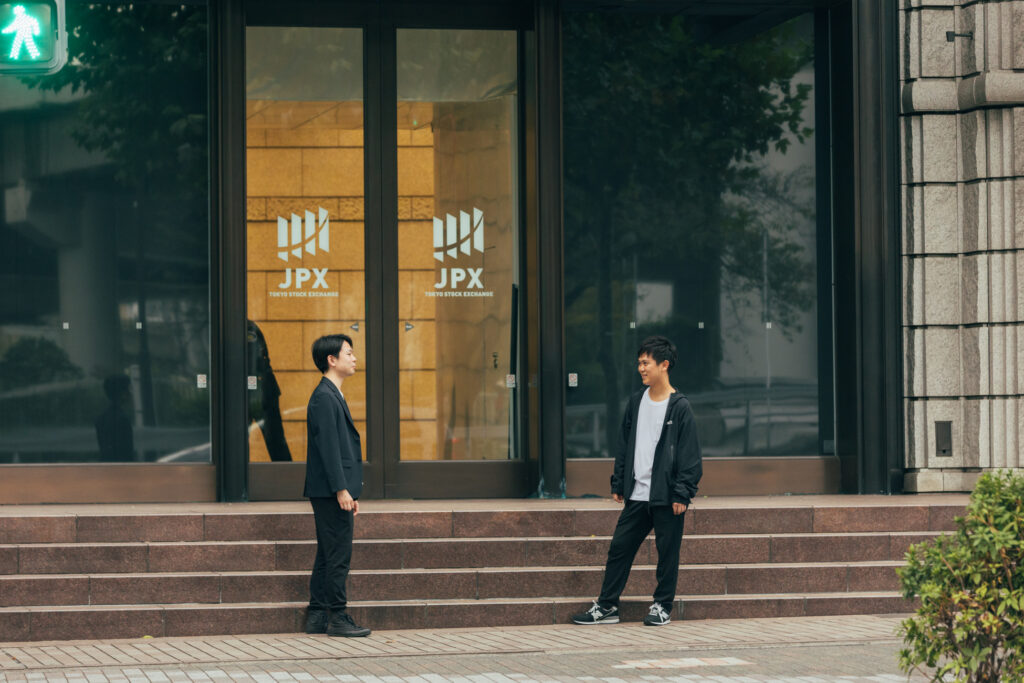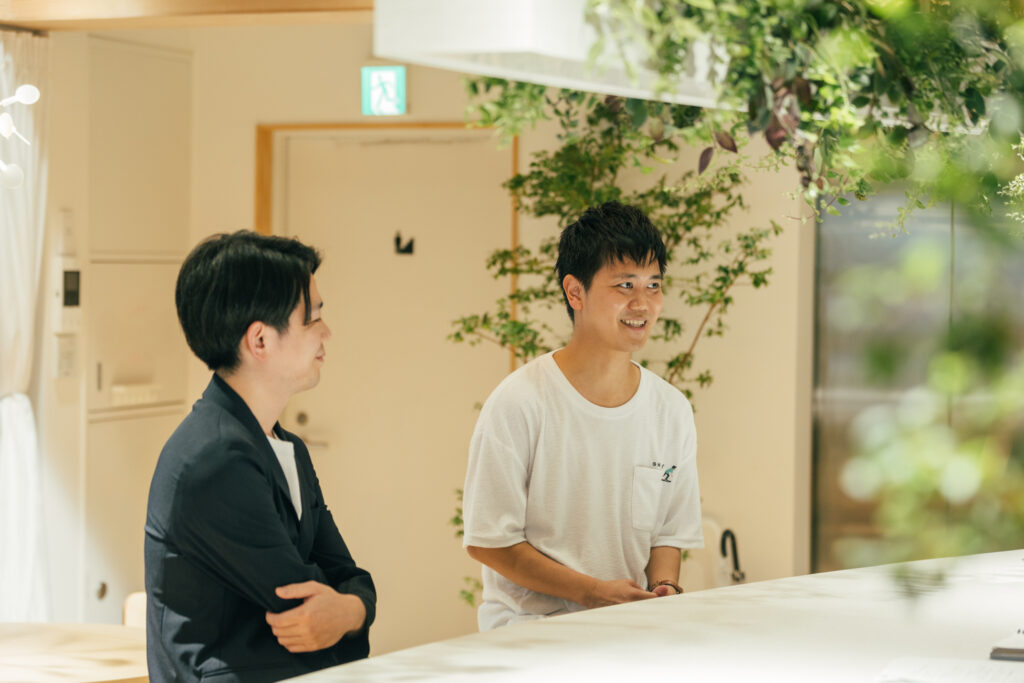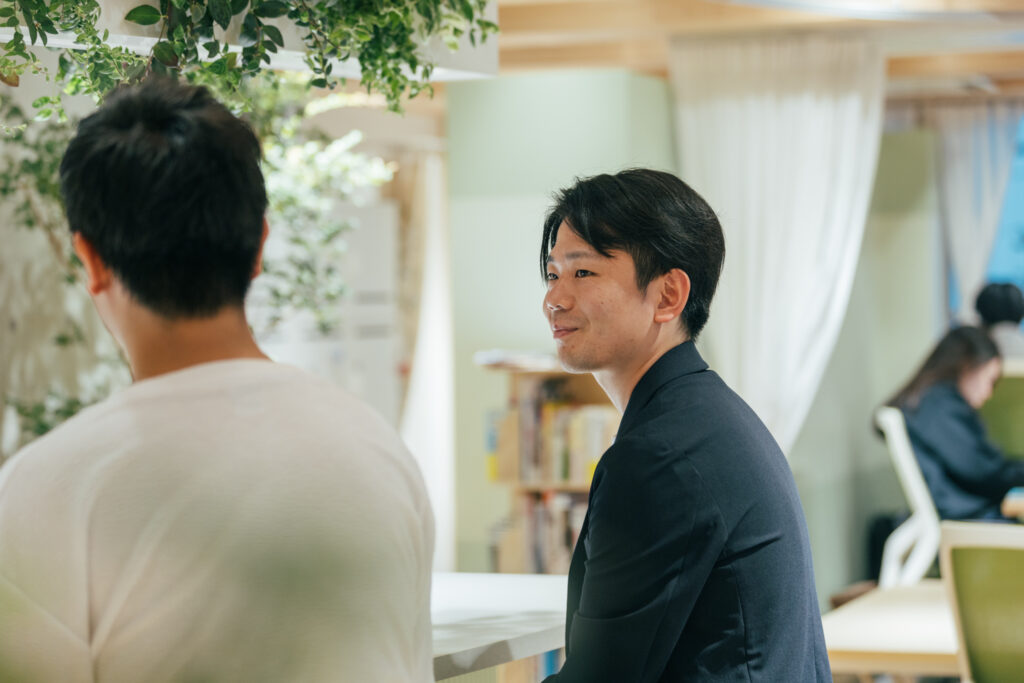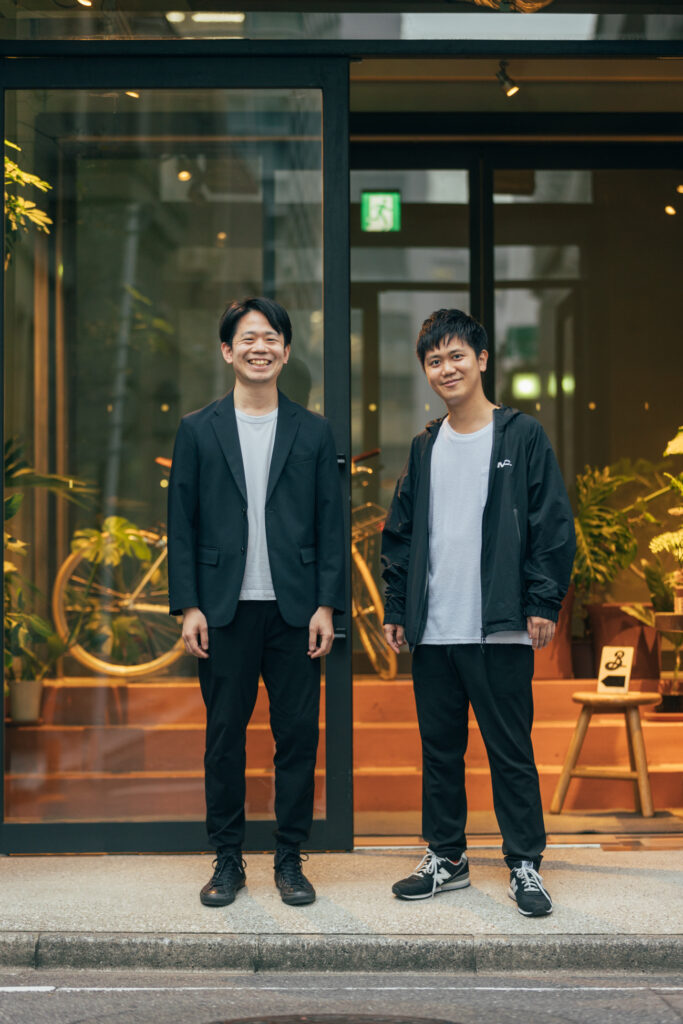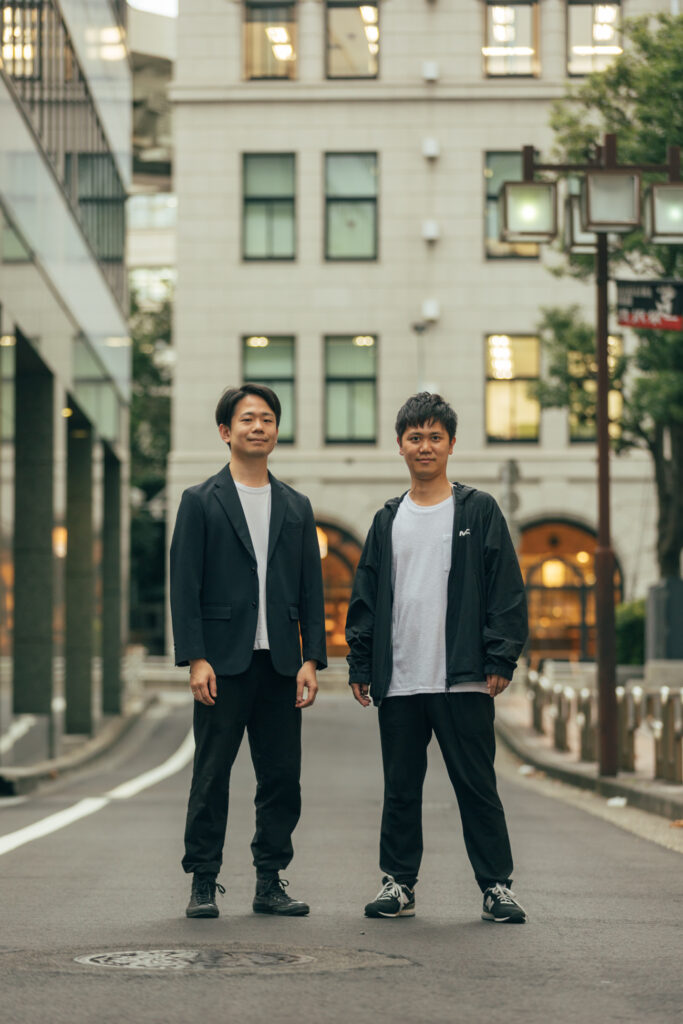


2023.12.08
Takumi Nakayama, Kazutoshi Murakami
Saxophonist / Representative Director of JAZZ SUMMIT TOKYO (Nakayama), Drummer / Director of JAZZ SUMMIT TOKYO (Murakami)
A city where innovative winds blow
Spreading jazz and scale from Kabutocho
Since 2018, Kabutocho, in Nihonbashi, has hosted the annual JAZZ EMP (Emerging Musicians Program) and this year also began "MONDAY JAZZ" at KABEAT and "UNDER JAZZ" at B by the Brooklyn Brewery (colloquially known as ‘B’). We spoke with Takumi Nakayama, a saxophonist, and representative of "JAZZ SUMMIT TOKYO," and Kazutoshi Murakami, a drummer, about jazz and its expanding scene in the Kabutocho area.
●The “JAZZ EMP” first began at the Tokyo Stock Exchange in 2018 and has been influential in providing a platform for jazz musicians in Japan to express themselves. (this year it will be held at KABUTO ONE on December 10). It has also helped to bring an air of innovation to Kabutocho, which from the outside is often only seen as a financial district. When we spoke with Masayori Shoji of the “JAZZ EMP” Executive Committee, we were pleased to hear him say, “This project was launched to create a connection between finance and jazz, to give the Kabutocho area a new identity, and most importantly, to help solve issues faced by both the jazz and financial industries.”
(Nakayama) I participated in the first JAZZ EMP as a musician. Once the pandemic had struck, JAZZ EMP stepped out of its usual home, the Tokyo Stock Exchange, and branched out into KABEAT. This coincided with the inaugural “Kabutocho Night Market” in December 2022, which was well received. We also started our own company at that time and we also set up our office in Kabutocho. We also started “MONDAY JAZZ” (held once every two months on a Monday night) at KABEAT in April of this year.
●When you hear the word “jazz,” you might have the impression that it’s difficult to understand or approach, or that it has a high barrier to entry. However, with the introduction of live jazz performances at KABEAT and “B” on weekday evenings in Kabutocho, we are seeing many office workers stopping by on their way home from work to casually enjoy authentic, live jazz music.
(Nakayama) As you mentioned, jazz sometimes has an image of being difficult or unapproachable, and I think there is also a challenge in trying to engage young people to take an active role in jazz. However, our sponsors have helped to make jazz more accessible to people who want to come and enjoy live performances, whilst also financially supporting the musicians. The revitalization of Kabutocho began with K5 hotel, and now that the town is surrounded by restaurants, art galleries, and other multifaceted elements, there is a real three-dimensional structure to the area that allows for events such as “MONDAY JAZZ” and “UNDER JAZZ” (a jazz event held on the first Tuesday of each month at “B” – although there are no shows in January). This is helping to make jazz music more accessible to the public and I think it’s great timing.
(Murakami) The response from people so far has been very warm. I see sponsors enjoying themselves in the front rows, and from a musician’s point of view, I think it makes for an environment that puts them at ease and makes it easy to perform.
●The timing of the applause or cheers from the audience and the atmosphere it creates also greatly affects the performance, doesn’t it?
(Nakayama) Some masters nurture their audience and can make the musicians and audience feel immersed together from the moment they enter the venue.
●The other day, I had a chance to visit a jazz cafe in Iwate called “BASIE”. I heard that the owner there selects his records based on the people who come in. I was amazed by his attitude: of not being self-indulgent, but rather, remaining in tune with his customers.
(Nakayama) I went there once when I was a student, and the owner suddenly asked me to perform! I played the saxophone alongside a drummer, and I was amazed to find that the record he played right after we performed was a soundtrack of artists that both I and the drummer most admired.
●It felt like a “live” musical experience. The owner recreates this atmosphere in the shop, almost like a “time machine” that allows young people to experience the same performances that the owner himself experienced back in the day. It’s as if that town nurtures jazz, and that perhaps the lineage of jazz has been passed down through shared experiences that create this unique atmosphere in the cafe itself.
(Nakayama) I think it’s important to have these truly unique experiences. It’s thanks to these environments, where musicians can produce sounds without stress, that I was able to develop a passion for jazz. Now that I think about it, one of the missions of “Jazz Summit Tokyo” is to create such an environment. The way you receive sound is different depending on its context. So when you happen to see a musician performing on the street, it will feel and sound different to when you enjoy the music in a venue with good acoustics or while enjoying a delicious meal.
●What was the impetus behind the launch of “JAZZ SUMMIT TOKYO”?
(Nakayama) I began to realize the importance of connecting musicians with venues. At the same time, I also began to notice the aging jazz population and began to wonder what jazz would look like in the near future. So, I decided: “Now is the time for matching musicians who want to create live music but don’t have a proper venue, with audiences who want to appreciate live music but aren’t able to access it” So I asked Murakami, who performed at the “JAZZ EMP” in 2019, to join me in launching the project in April 2021. “JAZZ SUMMIT TOKYO” is also developing a few other products and services that will allow people to enjoy original jazz videos with high-quality imagery and sound.
●Is there anything that you have noticed since starting the company?
(Nakayama) Jazz is an individualistic form of music. For rock and pop music, people work together as a band, but in jazz, the members who play today may be different from the ones who play tomorrow. So, I began to think of ways that we might be able to do something as a corporation, rather than as individuals. When we actually began performing live in Kabutocho, the social significance of what we were doing began to grow.
(Murakami) Jazz has history and tradition, but I want us to bring it to a new generation. We know jazz, but there’s also so much we can learn from growing the scene and building the atmosphere of Kabutocho together.
(Nakayama) Food and Jazz go well together, and Kabutocho has many attractive venues. You can experience a wide range of performances thanks to “MONDAY JAZZ” and “UNDER JAZZ.”
●What are the differences in the music you perform?
(Nakayama) KABEAT, with its large windows and good visibility, hosts a variety of music from pop to Latin and other seasonal and traditional tunes that suit a wide range of clientele. In contrast, “B” located underground in the basement of K5, is equipped with one of the best sound systems in Tokyo, which means it’s capable of playing danceable and funky tunes at a high volume. We always consider the atmosphere of the venue when we book musicians to make sure we’ve got the right fit.
(Murakami) I’ve always been exposed to jazz through different kinds of music, rather than solely from music coming from the jazz world. So I think it would be great if KABEAT could introduce people to jazz through a diverse range of music and unexpected encounters. Whilst, of course, delivering great live quality.
(Live video from “Monday Jazz” at KABEAT on June 19, 2023)
●KABEAT is a restaurant that uses food from a wide variety of producers, from all over Japan. I think that the food and dining concept works well with the music and vice versa. The QR code ordering system also means patrons can order during the live performances without causing a disturbance, which is a nice touch.
(Nakayama) Live Jazz music is a form of interaction between the musician and the audience. I feel that at KABEAT people calmly listen to the music, whereas at ‘B’ my impression is that there is less distance between the performer and the audience and that they each enjoy each other’s company.
●I think Jazz can often have this image of being difficult to approach. Will you try to change this perception in order to better integrate it into the city?
(Nakayama) I think it depends on your attitude. Jazz is definitely an art form, but I think it depends on the extent to which it can be presented as entertainment. After all, at its core, it’s a relationship between people. Since KABEAT and “B” have great food offerings, I want to use these venues to break down the boundaries between artists and audiences and really foster communication to create a “community that shares music”.
(Takumi Nakayama performed with guitarist Naoto Suzuki at KABEAT during the Kabuto-cho Night Market Music Fest on October 29, 2023)
●What do you think are some of the challenges facing the jazz world?
(Nakayama) I think capacity is an issue. Venues such as Cotton Club in Marunouchi or Blue Note Tokyo have a maximum capacity of around 300 people. The maximum capacity of most jazz concerts is quite small. And so, people tend to stick to the conventional image of “tonight’s show was a success because we had 50 people in the audience.” But from the perspective of a successful rock musician who has toured and performed in arenas, a 300-person performance is just an acoustic set. That kind of thinking is what’s missing in the jazz world today, and I believe that now is the time for jazz musicians to change their mindset.
●What do you think can be achieved here in Kabutocho?
(Nakayama) I think Kabutocho represents an opportunity for businesses to get involved in music. Up until now, music has been strictly for individuals and consumed by individuals. But Kabutocho is able to make business-to-business relationships possible in music through sponsorship, and I think this is what is helping to revitalize the city. I think the next step is to explore what kind of landscape we can make with a capacity of 150 to 300 people, and then in the future, I hope we can make the city more interesting through jazz while making this vortex bigger and bigger.
(Murakami) Many of the people around us work full time whilst playing jazz on the side, which means their performances have become secondary. Firstly, we want to succeed in Kabutocho and make this a viable case study. Once we achieve that, I would like to lay the groundwork to promote culture in Kabutocho through more experimentation.
Jazz EMP@ Tokyo Financial Street 2023
Date: Sunday, December 10, 2023 12:00 – 18:00
Venue: KABUTO ONE 4F Hall (directly connected to Kayabacho Station on the Subway Tozai Line)
Jazz EMP (Jazz Emerging Musicians Program) is a Jazz event that brings together the best young Emerging Musicians in Kabutocho and Kayabacho, Nihonbashi, to present a special showcase of music for one day only.
This year, the event will be held at KABUTO ONE, a new landmark in Kabutocho.
Click here to register for online viewing tickets (free admission) https://teket.jp/8457/29220
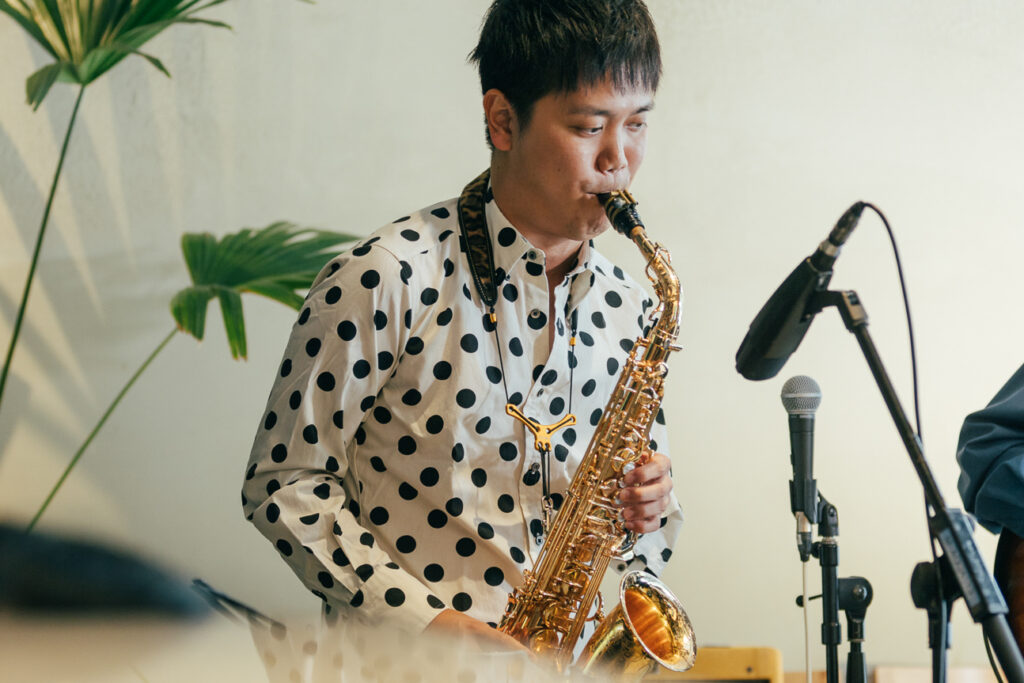
Takumi Nakayama
Saxophonist born in Shizuoka, Japan in 1992. He graduated from Kunitachi College of Music at the top of his class and was a member of the Waseda University High Society Orchestra during his college years and has received numerous awards. In April 2021, he established “JAZZ SUMMIT TOKYO” and became its representative director. He also established “MONDAY JAZZ” and “UNDER JAZZ,” creating a platform that matches musicians with audiences. Thanks to his experience and outward perspective, Nakayama has successfully brought out the charm and new possibilities of jazz.

Kazutoshi Murakami
Drummer born in Kanagawa, Japan in 1994. Upon graduating from Kunitachi College of Music with a major in jazz, he completed the percussion soloist course at the same college. He has been actively involved in his own live performances while also supporting other artists for jazz and classical concerts, as well as musicals. He also teaches at Shimamura Gakki. After participating in “JAZZ EMP”, he joined the management of “JAZZ SUMMIT TOKYO” with Takumi Nakayama and became a director. He contributes to the participation of musicians in society by providing online support for jazz performers and other activities from a performer’s point of view.
Text : Jun Kuramoto
Photo : Naoto Date
Interview : Jun Kuramoto

